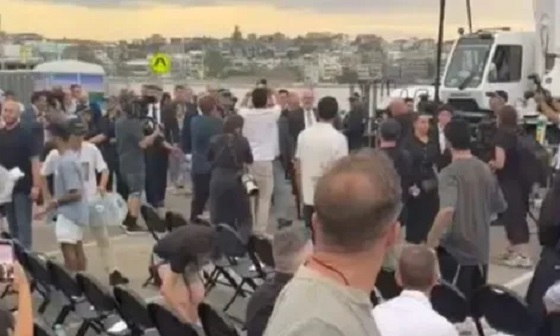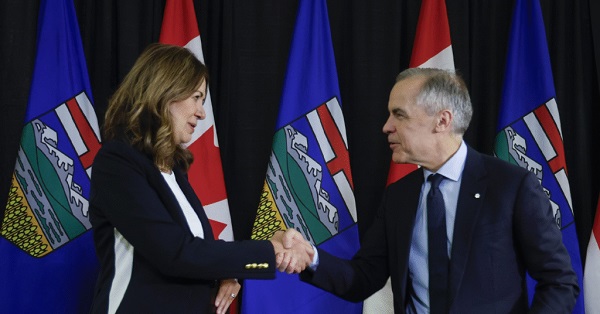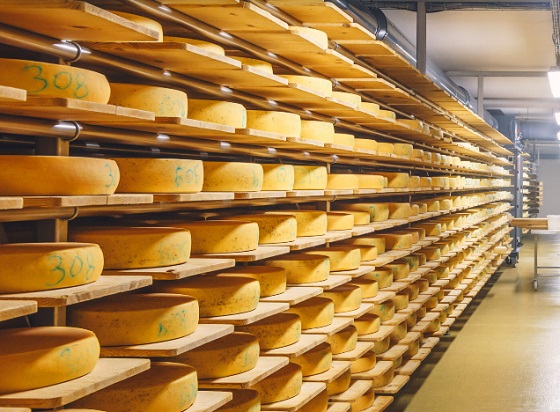Business
Canada’s productivity and prosperity slump

From Resource Works
“The U.S. is on track to produce nearly 50 percent more per person than Canada will. This stunning divergence is unprecedented in modern history.”
National productivity is key to our personal prosperity and standard of living—and we’re in trouble.
Canada’s productivity, a measure of our efficiency in producing goods and services, has been seriously slumping for years, and we are now one of the least productive G7 nations.
Now, business leaders say part of the solution could, and should, lie in producing natural resources and supercharging the resource sector.
The Royal Bank of Canada reports: “The Canadian economy has continued to underperform global peers. Declines in per-capita output in seven of the last eight quarters have left average income per person back at decade-ago levels, and the unemployment rate has risen more than in other advanced economies.
“Canada is not ‘officially’ in a recession… but per-capita gross domestic product and the unemployment rate are more representative of what individual households and workers are experiencing in the current economy, and on that basis, it certainly feels like one.”
Now, a new report by the Canadian Chamber of Commerce says a comprehensive national strategy is needed to promote resource investments.
“We really need to lean into our strengths as a country,” says report author Andrew DiCapua. “We are lucky to live in a country where we have abundant natural resources… We should be trying to find ways to attract investment to supercharge the sector.”
Senior economist DiCapua notes: “With Canada facing significant economic challenges—below-trend growth, declining living standards, regulatory uncertainty, and weak business investment—the Canadian economy is not keeping pace.
“The main recommendation here is to create regulations and policies that provide regulatory certainty—or rather clarity—so that investment can be attracted into this crucial (natural-resource) sector.”
The national business group says the new approach should include streamlining government regulations, recognizing the need for timely approval of major projects, and ensuring policy stability.
It also recommends speeding up the delivery of investment tax credits for projects that cut emissions and adopting a trade infrastructure plan to ensure the country has sufficient roads, ports, and energy transmission lines for accessing resources in remote areas.
The Chamber notes that the natural-resources sector is the second-largest in Canada, paying compensation last year that was $25,000 more than the national average.
“The sector can do this because of its productivity prowess, which is closely linked to the country’s prosperity and long-term standard of living. This is why increasing investment in high-productivity sectors, particularly within natural resources, is an obvious remedy to our productivity challenges.”
And it adds: “Given the natural resources sector’s higher-than-average Indigenous workforce participation, higher wage opportunities can help increase Indigenous employment and economic participation, furthering economic reconciliation efforts by supporting Indigenous-owned businesses, equity partnerships, and employment.”
Economists, business leaders, and the Bank of Canada have highlighted the country’s productivity woes for years—and the level of concern is growing.
As TD Economics pointed out in a worrisome report: “Canadians’ standard of living, as measured by real GDP per person, was lower in 2023 than in 2014.
“Without improved productivity growth, workers will face stagnating wages, and government revenues will not keep pace with spending commitments, requiring higher taxes or reduced public services.”
And: “Over the decade prior to the pandemic, business sector productivity grew at a respectable rate of 1.2% annually. Since 2019, it has ceased to expand at all, setting Canada apart as one of the worst-performing advanced economies, not to mention in stark contrast to the United States…
“The woes are widespread. Relative to growth in the decade prior to the pandemic, only a few service industries have managed to improve their performance… To get the same output, it now requires more hours from workers. Hard to believe this could occur in a digital age.”
Economist Trevor Tombe of the University of Calgary states: “The gap between the Canadian and American economies has now reached its widest point in nearly a century.
“If this continues, we’ll not have persistently seen this wide of a gap since the days of John A. Macdonald… Taking bolder action to address this growing prosperity gap is needed. And fast.
“The U.S. is on track to produce nearly 50 percent more per person than Canada will. This stunning divergence is unprecedented in modern history.”
Earlier this year, Carolyn Rogers, senior deputy governor of the Bank of Canada, gave this warning on our productivity: “You’ve seen those signs that say, ‘In emergency, break glass.’ Well, it’s time to break the glass.”
Rogers said in a Halifax speech: “An economy with low productivity can grow only so quickly before inflation sets in. But an economy with strong productivity can have faster growth, more jobs, and higher wages with less risk of inflation…
“We thought productivity would improve coming out of the pandemic as firms found their footing and workers trained back up. We’ve seen that happen in the US economy, but it hasn’t happened here. In fact, the level of productivity in Canada’s business sector is more or less unchanged from where it was seven years ago.”
It’s beyond time for our federal and provincial governments to get in gear and take steps to help get our productivity back on track.
The Chamber of Commerce’s recommendations would be a good place to start: adopt sensible regulations and stable policies that encourage investment in our natural resources, and speed up the approval of major projects.
Business
Warning Canada: China’s Economic Miracle Was Built on Mass Displacement

If you think the CCP will treat foreigners better than its own people, when it extends its power over you, please think again: Dimon Liu’s warning to Canadian Parliament.
Editor’s Note: The Bureau is publishing the following testimony to Canada’s House of Commons committee on International Human Rights from Dimon Liu, a China-born, Washington, D.C.-based democracy advocate who testified in Parliament on December 8, 2025, about the human cost of China’s economic rise. Submitted to The Bureau as an op-ed, Liu’s testimony argues that the Canadian government should tighten scrutiny of high-risk trade and investment, and ensure Canada’s foreign policy does not inadvertently reward coercion. Liu also warns that the Chinese Communist Party could gain leverage over Canadians and treat them as it has done to its own subjugated population—an implied message to Prime Minister Mark Carney, who has pledged to engage China as a strategic partner without making that position clear to Canadians during his election campaign.
OTTAWA — It is an honor to speak before you at the Canadian Parliament.
My testimony will attempt to explain why China’s economic success is built on the backs of the largest number of displaced persons in human history.
It is estimated that these displaced individuals range between 300 to 400 million — it is equivalent to the total population of the United States being uprooted and forced to relocate. These displaced persons are invisible to the world, their sufferings unnoticed, their plights ignored.
In 1978, when economic reform began, China’s GDP was $150 billion USD.
In 2000, when China joined the WTO, it was approximately $1.2 trillion USD.
China’s current GDP is approximately $18 trillion USD.
In 2000 China’s manufacturing output was smaller than Italy’s.
Today it’s larger than America, Europe, Japan, and South Korea combined.
If you have ever wondered how China managed to grow so fast in such a short time, Charles Li, former CEO of the Hong Kong Stock Exchange, has the answers for you.
He listed 4 reasons: 1) cheapest land, 2) cheapest labor, 3) cheapest capital, and 4) disregard of environmental costs.
“The cheapest land” because the CCP government took the land from the farmers at little to no compensation.
“The cheapest labor,” because these farmers, without land to farm, were forced to find work in urban areas at very low wages.
The communist household registration system (hukou 戶口) ties them perpetually to the rural areas. This means they are not legal residents, and cannot receive social benefits that legal urban residents are entitled. They could be evicted at any time.
One well known incident of eviction occurred in November 2017. Cai Qi, now the second most powerful man in China after Xi Jinping, was a municipal official in Beijing. He evicted tens of thousands into Beijing’s harsh winter, with only days, or just moments of notice. Cai Qi made famous a term, “low-end population” (低端人口), and exposed CCP’s contempt of rural migrants it treats as second class citizens.
These displaced migrant workers have one tradition they hold dear — it is to reunite with their families during the Chinese Lunar New Year holiday, making this seasonal migration of 100 to 150 million people a spectacular event. In China’s economic winter of 2025 with waves of bankruptcies and factory closures, the tide of unemployed migrant workers returning home to where there is also no work, and no land to farm, has become a worrisome event.
Historically in the last 2,000 years, social instability has caused the collapse of many ruling regimes in China.
“The cheapest capital” is acquired through predatory banking practices, and through the stock markets, first to rake in the savings of the Chinese people; and later international investments by listing opaque, and state owned enterprises in leading stock markets around the world.
“A disregard of environmental costs” is a hallmark of China’s industrialization. The land is poisoned, so is the water; and China produces one-third of all global greenhouse gases.
Chinese Communist officials often laud their system as superior. The essayist Qin Hui has written that the Chinese communist government enjoys a human rights abuse advantage. This is true. By abusing its own people so brutally, the CCP regime has created an image of success, which will prove to be a mirage.
If you think the CCP will treat foreigners better than its own people, when it extends its power over you, please think again.
The Bureau is a reader-supported publication.
To receive new posts and support my work, consider becoming a free or paid subscriber.
Business
Judge Declares Mistrial in Landmark New York PRC Foreign-Agent Case

U.S. District Judge Brian Cogan declared a mistrial Monday afternoon in the high-profile foreign-agent and corruption case against former New York state official Linda Sun and her husband Chris Hu, after jurors reported they were hopelessly deadlocked on all 19 counts.
After restarting deliberations Monday morning with an alternate juror, the panel sent a note to Judge Cogan stating:
“Your honor, after extensive deliberations and redeliberations the jury remains unable to reach a unanimous verdict. The jurors’ positions are firmly held.”
Cogan brought the jury into court and asked the foreman whether they had reached agreement on any counts. They replied that they were deadlocked on every one. The judge then declared a mistrial.
Assistant U.S. Attorney Alexander Solomon immediately told the court that the government intends to retry the case “as soon as possible.” A status conference is scheduled for January 26, 2026, to determine next steps.
Jury selection began November 10, 2025, and the government called 41 witnesses to the stand, compared with eight for the defense and one rebuttal witness for the prosecution. Deliberations began on December 12, and by this afternoon the jurors had sent three notes to the court — each indicating deadlock.
As The Bureau reported in its exclusive analysis Friday, the panel’s fracture had become visible as jurors headed into a second week of deliberations in a landmark foreign-agent and corruption trial that reached into two governors’ offices — a case asking a jury of New Yorkers to decide whether Sun secretly served Beijing’s interests while she and Hu built a small business and luxury-property empire during the pandemic, cashing in on emergency procurement as other Americans were locked down.
Prosecutors urged jurors to accept their account of a dense web of family and Chinese-community financial transactions through which Sun and Hu allegedly secured many millions of dollars in business deals tied to “United Front” proxies aligned with Beijing. The defense, by contrast, argued that Sun and Hu were simply successful through legitimate, culturally familiar transactions, not any covert scheme directed by a foreign state.
Sun and Hu face 19 charges in total, including allegations that Sun acted as an unregistered foreign agent for the People’s Republic of China; visa-fraud and alien-smuggling counts tied to a 2019 Henan provincial delegation; a multimillion-dollar pandemic PPE kickback scheme; bank-fraud and identity-misuse allegations; and multiple money-laundering and tax-evasion counts.
Prosecutors have argued that the clearest money trail ran through New York’s COVID procurement scramble and a pair of Jiangsu-linked emails. In closing, Solomon told jurors that Sun’s “reward” for steering contracts was “millions of dollars in kickbacks or bribes,” contending the money was routed through accounts opened in Sun’s mother’s name and via friends and relatives.
The government has tied those claims to a broader narrative — laid out in Solomon’s summation and dissected in The Bureau’s reporting — that Sun functioned as a “trusted insider” who repurposed state access and letterhead to advance Beijing’s priorities, including by allegedly forging Governor Kathy Hochul’s signature on invitation letters used for Chinese provincial delegations, while keeping those relationships hidden from colleagues. The defense, in turn, urged jurors to reject the government’s picture of clandestine agency and argued prosecutors had overreached by treating ordinary diaspora networking, trade promotion, and pandemic procurement as criminal conduct — insisting none of the evidence proved the “direction or control” element central to the Foreign Agents Registration Act.
Whether a future jury will see the same evidence as corruption and covert foreign agency or as culturally familiar commerce and politics — will now be tested again, on a new timetable, in a courtroom that has already shown just how difficult this record is to unanimously interpret.
The Bureau is a reader-supported publication.
To receive new posts and support my work, consider becoming a free or paid subscriber.
-

 International2 days ago
International2 days agoAustralian PM booed at Bondi vigil as crowd screams “shame!”
-

 Uncategorized2 days ago
Uncategorized2 days agoMortgaging Canada’s energy future — the hidden costs of the Carney-Smith pipeline deal
-

 Alberta1 day ago
Alberta1 day agoAlberta Next Panel calls to reform how Canada works
-

 Automotive1 day ago
Automotive1 day agoCanada’s EV gamble is starting to backfire
-

 Digital ID19 hours ago
Digital ID19 hours agoCanadian government launches trial version of digital ID for certain licenses, permits
-

 Agriculture1 day ago
Agriculture1 day agoEnd Supply Management—For the Sake of Canadian Consumers
-

 Business18 hours ago
Business18 hours agoThe “Disruptor-in-Chief” places Canada in the crosshairs
-

 International19 hours ago
International19 hours agoWorld-leading biochemist debunks evolutionary theory






